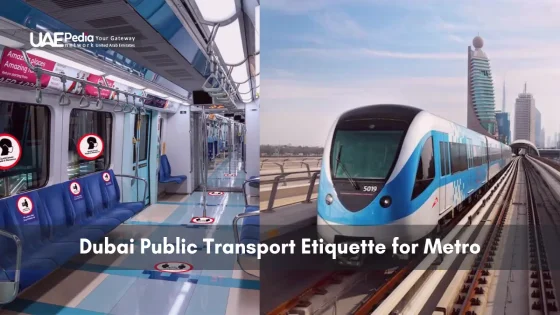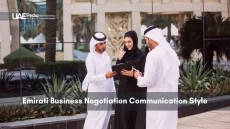Did you know over half a million passengers glide through air-conditioned stations daily in one of the world’s most efficient rail networks? This seamless dance of commuters thrives on unspoken rules—ones we’ll decode today.
Every city has its rhythm, and here, the metro isn’t just about getting from Burj Khalifa to the Gold Souk. It’s where sleek carriages become melting pots of cultures, all moving to the beat of shared courtesy. Understanding these norms transforms your ride from functional to frictionless—whether you’re a resident chasing meetings or a visitor chasing sunsets.
We’ve ridden every line, observed the quiet nods between regulars, and gathered insights from transit authorities. From priority seating customs to the art of queueing (yes, there’s an art), small gestures keep this urban engine humming. After all, a smooth journey isn’t just about arriving on time—it’s about how we travel together.
Dubai Metro operates two automated lines (Red 67 km, Green 23 km) with 3–7 min headways, 5 AM–midnight service, and zone-based fares (AED 3–15). Board the correct cabin: pink-marked women-and-children cars, blue priority seats, and green mixed sections.
Queue diagonally behind yellow safety line; let passengers exit first, then enter promptly. No eating, drinking, or littering (fines AED 100–200). Wear backpacks front-style, keep bags vertical, and fold strollers before boarding. Use Nol Silver/Gold/Red cards via app or kiosks; top-up AED 20–200.
Key Takeaways:
- Trains run every 3–7 minutes precisely.
- Nol Card enables seamless contactless payments.
- Obey boarding zones to reduce delays.
- Priority seats reserved for vulnerable passengers.
- No eating or drinking onboard allowed.
- Zone-based fares offer cost savings.
Getting Started on the Dubai Metro Adventure
Picture this: a rail network so sleek it feels like gliding above sand dunes. The city’s backbone connects glittering malls to historic districts, all while offering panoramic views of architectural marvels. Let’s unlock this urban labyrinth.
An Overview of the Metro System and Lines
Two primary arteries—Red and Green—crisscross the city. The Red Line zips past landmarks like the Burj Khalifa and Dubai Mall, while the Green Line weaves through older neighborhoods. Trains arrive every 3-7 minutes, making clockwork precision part of the experience.
Pro tip: Grab a window seat on the Red Line between Financial Centre and Mall of the Emirates. You’ll catch sunset hues painting the skyline—a free show with your commute.
Using the Nol Card and Ticket Options
Your golden ticket? The rechargeable Nol Card. Available in Silver (standard), Gold (premium seating), and Red Ticket (single rides), it’s your key to frictionless travel. Tap-in stations sell cards, but save time by purchasing at grocery stores or online.
Top-up kiosks glow like desert fireflies in every station. Load AED 20 for short trips or AED 100 for week-long budget-friendly adventures. Contactless payments? They’ve mastered it before it was cool.
The Nol Card system offers multiple ticket types (Silver, Gold, Red) with flexible top-up options, making urban transit seamless and user-friendly Ref.: “Dubai Metro Rules and Fines Guide” (2024). JobXDubai Blog.
Understanding Dubai Public Transport Etiquette Metro
Ever watched a ballet? That’s what efficient boarding looks like here—a synchronized flow where everyone knows their part. The secret lies in three simple principles: patience, spatial awareness, and letting the system work as designed.
The Do’s and Don’ts of Boarding and Exiting
First rule: never rush the doors. Wait until the carriage empties—it’s like holding a door open for someone, but on wheels. RTA data shows this single act reduces delays by 22% during peak hours. See those yellow markings? They’re not decor. Stand behind them until the train stops completely.
- Do: Check both sides before stepping in—some stations have boarding zones on alternating sides
- Don’t: Lean against doors (they’re pressure-sensitive and will reopen, costing precious minutes)
- Pro tip: If carrying bags, position them vertically—it frees up space faster than Tetris
Blocking aisles isn’t just rude—it’s costly. Fines up to AED 200 apply for door obstruction. Regulars use a clever hack: board the middle cars. They’re often less crowded than front/rear sections.
“A smooth journey starts before you step inside—respect the flow, and the flow respects you.”
Notice how locals queue? They form diagonal lines near pillars, leaving center paths clear. Mimic this formation, and you’ll glide through like a seasoned commuter. Remember: courtesy keeps the city moving.
Read More:
Embracing Safety and Courtesy in the Commute
Imagine a silent agreement among strangers—one where folded strollers automatically clear walkways, and tired shoulders find rest without asking. This unspoken pact powers the heartbeat of urban mobility here. Let’s explore how small acts of awareness keep the rhythm steady.
Priority Seating and Respect for Vulnerable Passengers
Those blue seats near doors aren’t just comfy real estate. They’re lifelines for expectant mothers, seniors, and anyone needing a moment’s respite. Regulars have a sixth sense for spotting hidden needs—a slight wince, a cane tucked discreetly. Offering your spot? It’s less about chivalry, more about collective care.
Pro tip: Stand up before someone asks. A simple “Would you like to sit?” bridges language barriers. Stations even mark priority zones with tactile paving—textured ground that whispers “pause here” to those who need it most.
Priority seating areas are designed to provide comfort and accessibility for expectant mothers, seniors, and passengers with special needs, reflecting the city’s commitment to inclusive urban mobility Ref.: “Dubai Metro Etiquette” (2025). Day of Dubai Articles.
Maintaining Orderly Lines and Queue Etiquette
Ever noticed how boarding resembles a well-rehearsed jazz improv? Diagonal queues form naturally near pillars, creating fluid channels. The secret? Stand where the floor arrows point, let exiting passengers flow through first, then step in briskly. It’s not rush hour—it’s flow hour.
“We move faster when we move together,” says Amal, a daily commuter. “It’s like sand shifting—every grain finds its place without friction.”
Yellow waiting zones aren’t suggestions—they’re science. Stay behind until doors fully open. Carrying groceries? Tuck bags vertically like date palms. This transit system thrives on precision, and your spatial awareness keeps its gears oiled.
Maintaining Cleanliness on Board and at Stations
Think of the metro as a spotless oasis—every gleaming surface tells a story of collective pride. This isn’t just about rules; it’s about preserving a shared space where comfort meets civic pride.
No Eating, Drinking, or Littering Policies
That aroma of fresh coffee? Save it for the café. Consuming food or beverages here isn’t just frowned upon—it’s strictly prohibited. Why? Crumble-free seats and spill-proof aisles keep everyone’s journey crisp. Violators face fines up to AED 100, a gentle reminder that communal spaces thrive on mutual respect.
You’ll spot “No Eating/Drinking” signs in three languages. Water bottles? Seal them until you exit. A traveler once joked, “It’s like being in a museum—you admire, but don’t touch the exhibits.” Trash bins glow like beacons at every turn. Use them. That gum wrapper? It’s a 10-second detour to keep the system pristine.
“Cleanliness here isn’t enforced—it’s embraced,” says Rasha, a daily rider. “We treat these carriages like our living rooms.”
Stations even have discreet cleaning crews who swoop in during brief stops. Your role? Simple: leave no trace. This golden rule ensures every passenger steps into freshness, ride after ride. After all, shared spaces stay sparkling when everyone plays their part.
Consuming food or beverages on the metro is strictly prohibited, with potential fines up to AED 100, ensuring a clean and hygienic transit environment Ref.: “Dubai Metro Commuter Hacks” (2025). JobXDubai Blog.
Managing Luggage and Personal Space Effectively
Ever juggled coffee while balancing bags on a moving train? Smart packing transforms crowded commutes into breezy journeys. Let’s master the art of traveling light without sacrificing essentials.
Securing Bags and Avoiding Aisle Blockages
Backpacks worn front-style create instant walkways—locals call this the “turtle technique.” Keep suitcases vertical like palm trees, not sideways like fallen logs. Pro tip: If your bag occupies floor space equal to a shoebox, you’re golden.
| Item | Smart Move | Space Saved |
|---|---|---|
| Backpack | Worn on chest | 12 inches |
| Rolling Bag | Vertical position | 8 inches |
| Shopping Bags | Combine into one | 6 inches |
| Stroller | Fold before boarding | 24 inches |
During rush hour, aisles become rivers of movement. A traveler once shared: “I treat my tote like a dance partner—always close, never stepping on toes.” Stations enforce AED 100 fines for blocked pathways, so keep belongings snug against seats or under legs.
Here’s your friendly guide to stress-free way travel:
- Stash small items in crossbody bags—they’re theft-resistant and space-savers
- Use luggage racks near doors for briefcase-sized items
- If standing, place bags between feet like bookends
“A well-packed bag is half the journey,” says Layla, a daily commuter. “The other half? Not becoming the journey’s obstacle.”
These adjustments turn chaotic rides into smooth experiences. Remember: shared spaces thrive when everyone’s gear stays contained. Your next trip becomes not just a commute, but a masterclass in urban harmony.
Understanding Nol Card and Ticketing Essentials
Your ticket to seamless travel isn’t just plastic—it’s a key to the city’s rhythm. The Nol Card works like a digital wallet for trains, buses, and even parking. With three types (Silver, Gold, Red) and auto-top-up options, it’s your backstage pass to urban mobility.
Purchasing, Topping Up, and Zone-Based Fares
Grab your card at convenience stores, stations, or online—no paperwork needed. Silver cards suit daily commutes, while Gold unlocks premium cabins. Pro tip: Link your card to the RTA app. Balance alerts prevent awkward “Oops, insufficient funds” moments at gates.
| Ticket Type | Best For | Savings |
|---|---|---|
| Single Ride | Quick trips | Base fare |
| Day Pass | Tourist explorers | 20% off 5+ rides |
| Monthly Silver | Regular commuters | 35% off peak fares |
Fares dance to a zone-based beat. The city splits into seven zones—cross more, pay slightly more. A two-zone afternoon ride costs less than a fancy coffee. Check route maps at stations: colored zone lines help budget smarter.
“I thought zones were complicated until I realized they’re like pizza slices—each has unique flavor, but together they make the whole pie,” shares Karim, a daily rider.
Top-up kiosks accept cards and cash. Load AED 50 for light use or AED 200 for week-long adventures. Remember: Cards work across the entire transit system, so that Gold Class upgrade? It applies to buses too. Knowledge here isn’t just power—it’s savings.
Respecting Designated Areas for Women and Children
Picture stepping into a space where every detail whispers protection—rose-tinted windows, stroller-friendly aisles, and seats designed for tender moments. These specialized cabins aren’t just sections; they’re sanctuaries where comfort meets cultural values.
How to Identify and Honor Specialized Cabins
Look for pink signage glowing like desert roses above platform edges. Symbols of strollers and female figures mark these zones—they’re impossible to miss. During rush hours, staff often guide travelers toward appropriate cars. A local mother shares: “It’s not about exclusion—it’s about creating breathing room for those who need it most.”
Pro tip: If you accidentally enter, exit calmly at the next stop. Regulars use a clever hack—stand near green-lit “mixed cabins” during off-peak times to avoid confusion.
Ensuring a Comfortable Environment for All
Cultural norms here prioritize dignity over debate. Visitors often notice how quickly non-eligible passengers retreat when approached—no words needed, just respectful nods. A tourist from Texas recalls: “I saw a man immediately swap cabins when a mother boarded. It felt like watching kindness in motion.”
“These spaces reflect our community’s heart—protecting the vulnerable isn’t optional, it’s instinct.”
Three quick reminders for smooth travels:
- Check cabin indicators before boarding—they’re displayed on platform screens
- Keep personal items from spilling into adjacent seats
- If traveling with older kids, use standard cabins to preserve the zone’s calm
These practices honor both tradition and modern urban needs. Whether you’re exploring historic districts or new towers, respecting these boundaries weaves courtesy into every journey.
Specialized cabins for women and children represent a cultural approach to ensuring comfort, safety, and respect in public transportation Ref.: “RTA Public Transport Rules” (2024). DXB Properties Blog.
Final Thoughts for a Smooth and Respectful Metro Journey
Navigating a bustling urban rail network becomes effortless when we move like synchronized gears—each small courtesy keeping the system humming. Remember those yellow boarding lines? They’re not just paint. They’re promises to let others exit first, creating ripple effects of efficiency across the city.
Keep bags compact, seats clean, and voices low. Those blue priority spots? They’re lifelines, not luxuries. Fines up to AED 200 remind us that shared spaces thrive on awareness. Trains run like clockwork from 5 AM to midnight (1 AM on weekends), with zone fares making cross-city trips surprisingly affordable.
Mastering metro etiquette transforms individual journeys into a collective, efficient urban experience, with trains operating from 5 AM to midnight (1 AM on weekends) Ref.: “Dubai Metro: A Guide” (2024). DAMAC Properties Blog.
Whether you’re racing to meetings or savoring skyline views, these habits transform rushed times into smooth transitions. The real magic lies not in the trains’ speed, but in how millions daily choose respect over rush.
Master these unspoken rules, and every day becomes a chance to glide through one of the planet’s most polished public transport networks. After all, the rhythm of a city isn’t just in its towers—it’s in how we travel between them.
You’ll risk a fine of up to AED 100. Keep snacks sealed until you’re off the train—grab a bite at stations like Dubai Mall or Burj Khalifa instead!
Look for pink signage on platforms and train doors. These cabins are usually at the front or middle of the train, offering a quieter space during rush hours.
Nope! Each rider needs their own card. Grab a Silver Nol card at any station kiosk—it’s reusable and works for buses, trams, and metro lines.
While not always fined, it’s a major etiquette no-no. Priority seats (marked in blue) are for seniors, pregnant travelers, and those with disabilities—always offer them if needed.
Fares depend on how many zones you cross. A one-zone trip costs AED 3, while a five-zone journey jumps to AED 7.50. Check maps at stations or use the RTA app to plan.
Absolutely! Fold them near doors or use dedicated spaces. Avoid blocking aisles, especially during peak hours when trains get crowded.
Yes, but keep it compact. Oversized luggage (over 90cm x 75cm) isn’t allowed—stick to metro-approved sizes or use taxis for bulkier items.
Yep! The Red Line stops at Terminals 1 and 3. Just tap your Nol card, and you’ll be sipping karak chai in Old Dubai within 20 minutes.
















